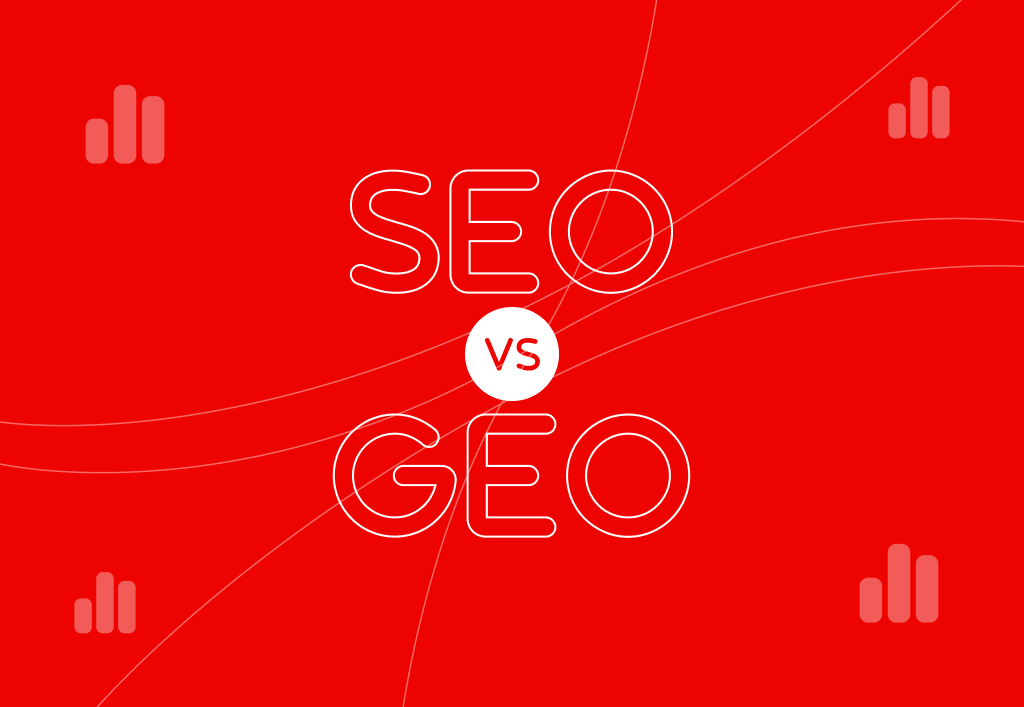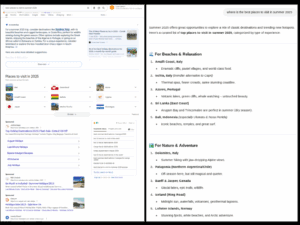
SEO vs GEO: What’s the difference?

Traditional search engine optimisation (SEO) predominantly focuses on improving rankings and visibility on platforms such as Google and Bing. Generative engine optimisation (GEO) is a new strategy aimed at creating optimised content to be cited or summarised in AI-driven answer engines including ChatGPT, Perplexity and SGE.
Why does this now matter? Search behaviour is changing; users don’t want to be scrolling through heaps of content, they want short & concise answers to solve their queries, meaning fewer clicks but more answers. Due to this, AI-generated summaries are becoming more prominent within the SERP and are increasingly replacing traditional search engine listings.
Being clickable & being answerable are now the two separate challenges your website will face, and mastering both is crucial for future proofing your content as SEO continues to evolve.
Need help optimising your content for GEO? Get in touch with the experts at Embryo and learn more about creating answerable content for AI-driven results.
What is SEO?
SEO is based on three main pillars, otherwise known as the (3 pillars of SEO). These are technical SEO, on-page SEO & off-page SEO. SEO is a well-known strategy which is focused on optimising websites to rank higher within the search engine results page (SERP).
SEO involves using target keywords with healthy amounts of search volume. Creating high-quality content to help the user journey on site and building relevant backlinks to the site to improve overall trust with Google, along with other tactics.
SEO’s main aim is to help increase overall site visibility and traffic by making search engines such as Google crawl and index the webpages. The result of this is either a boost in organic revenue if your website is ecommerce or increased organic leads if your site is more lead generation focused.
What is GEO?
Generative engine optimisation is a strategy more targeted to getting your content appearing in AI-generated answers. GEO focuses less on clicks but more on influence, visibility and authority in AI platforms.
Chat GPT Search Result Example
These specific types of search engines don’t just retrieve information based on the query typed in; they provide insightful & comprehensive guides by gathering information from multiple sources.
As GEO is about optimising content to increase visibility with the responses generated by AI-driven search engines, the best-performing content tends to be FAQ sections, clear & factual well-structured information, along with comparison/pros & cons pieces.
SEO vs GEO: What’s the real difference?

The main difference between SEO and GEO is the difference in targeting. While SEO is set out to appear in traditional SERPS, which lists a mixture of organic and paid results best suited to the user’s query. Whereas GEO is designed to target AI-driven search engines that will generate comprehensive guides and responses for the users.
| Factor | SEO | GEO |
| Goal | Rank higher in SERP to increase visibility. | Be cited/summarised in AI answer sections. |
| Wanted Audience Action | Increase CTR & Traffic to site. | Consume summary ( may not always lead to clicks). |
| How to Succeed | Ranking for Targetted keywords, High quality backlink profile and site performing well from a technical SEO standpoint. | Structure, Authority, Clarity and Factually correct content for the user. |
| Best Content Formats | Keyword optimised content and pages (in some instances long-from). | Bullet points, FAQ, and Concise summaries. |
| Metrics | Traffic, Clicks, Conversions & Rankings | Citations and Inclusions within AI overviews and answer sections. |
| Best Optimisation Tools | Google Search Console, Screaming Frog and AHREFs | Schema.org & AI citations. |
GEO optimisation strategies
A good generative optimisation strategy should focus on content structure, authority and trust signals aswell as technical elements.
Content structure
- Use question and answer formats. AI loves structured responses
- Add FAQ Schema where possible
- Focus on concise and scannable answers for the user (within 40-60 words)
Authority and trust signals
- Link Internally to relevant authoritative pages
- Include author bios and publication dates
- Optimise E-E-A-T (Experience, Expertise, Authority, Trustworthiness)
Technical elements
- Be sure to utilise structured data
- Ensure proper page hierarchy is in place
- Make sure canonical tags are in place to avoid duplicate content confusion
When to prioritise SEO vs GEO
SEO most certainly isn’t dead; however, it is ever changing, and with that said, you need to know when to prioritise SEO optimisation or when to switch to GEO and in some cases, it may even need a mix of both. Here is a quick summary to help you understand the basics!
| Prioritise SEO When… |
|
| Prioritise GEO When… |
|
| Blend Both When… |
|
Why is it important to integrate both strategies
As we have discussed, SEO & the SERP are forever changing, and with this comes updating existing strategies. We touched upon SEO driving clicks and GEO driving visibility, but the future of the SERP will begin to blend them both as Google SGE already shows. Therefore, you should be optimising for both SEO & GEO.
Search is no longer just Google
With users begging to get answers from AI engines such as ChatGPT, Perplexity and Google SGE and not traditional search engine results pages. Optimising only for SEO means that you are missing out on extra visibility in AI-generated responses where your competitors may be appearing.
SEO drives clicks but GEO drives influence
SEO helps your website rank and generate traffic. GEO helps your brand appear as trusted as they are visible in AI-generated summaries, even when users don’t click. Both support different stages of the buying/user journey.
GEO optimised content can boost SEO performance
Structuring your content for GEO by using FAQ’s, summaries, and schema markup can also enhance your SEO content by allowing crawlers to index quickly and boost ranking performance.
Cover the full funnel
- SEO = Top of funnel discovery and traffic
- GEO = Mid to lower funnel trust and authority
By combining both, you are ensuring that you’re visible at every stage of search behaviour.
GEO builds brand awareness
Even if users don’t visit your site, being cited in AI engines such as ChatGPT or SGE builds brand trust. This can lead to direct search, branded queries or even return visits in the future.
Measuring success in SEO vs GEO
Another key difference to note is the metrics used to measure success when comparing SEO and GEO
In SEO, we use metrics such as ranking positions for target keywords, conversions/leads or organic revenue, traffic to site and CTR to measure success.
However, these metrics won’t always be sufficient when it comes to measuring success for generative engines. When measuring success for generative engines, the metrics that are usually reviewed are appearances in AI-generated responses and brand mentions in AI answers.
Useful GEO tools for measuring success
As measuring success in AI search engines requires different metrics from traditional SEO, new tools are becoming more prominent to help marketers understand the impact their content is having in AI-powered search engines.
Tools such as HubSpot’s AI Search Grader and AHREFs’ new AI Citation overview are being introduced to help analyse your brand’s presence across AI-generated answers.

Key takeaways
- Traditional SEO IS NOT DEAD, but it is evolving.
- GEO is NOT a replacement, but it is a strategy for the AI-first internet
- Winning in both searches means not only an increase in visibility but also a boost in brand awareness and authority.
- Brands that adapt now will own the AI-powered answer spaces of the SERP moving forward.
Need to optimise your site for SEO and GEO? Embryo can help
With so many elements to get right, optimising content to appear in generative search engines aswell as mastering traditional SEO can be a challenge. At Embryo, our team of SEO and Content experts know exactly what it takes to come up with effective GEO strategies.
Check out our range of case studies or get in touch to learn more about how Embryo can help your business grow.


